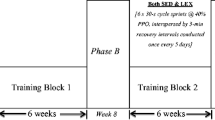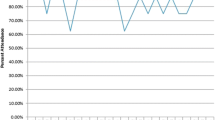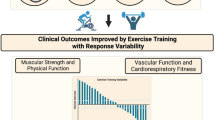Abstract
Background and aims: The level of physical functioning (PF) late in life has, in recent years, been shown to be influenced by genetic factors. One of the most extensively studied genetic variants associated with PF and trainability is insertion/deletion (I/D) polymorphism in the gene encoding Angiotensin Converting Enzyme (ACE). However, ACE studies have mainly been conducted among younger persons in excellent physical shape. In this study, we examine whether the level of PF, trainability, or rate-of-change are associated with the ACE genotype among the elderly. Methods: We used data from 4 randomized training studies of elderly Danes (N=203). The measures of PF were self-report, maximal oxygen uptake, muscle strength, walking speed, and body composition. Results: Overall, a favorable change in the measures of PF was observed in training groups compared with control groups. However, within groups, neither pre- or post-training/control period levels of PF nor differences in pre- and post-levels were associated with the ACE genotype. Conclusions: On the basis of our randomized studies, we could not detect any association between the ACE genotype and the level of PF or change, regardless of whether response to physical training or spontaneous changes was studied.
Similar content being viewed by others
References
Christensen K, McGue M, Yashin A, Iachine I, Holm NV, Vaupel JW. Genetic and environmental influences on functional abilities in Danish twins aged 75 years and older. J Gerontol 2000; 55: M446–52.
Christensen K, Gaist D, Vaupel JW, McGue M. Genetic contribution to rate of change in functional abilities among Danish twins aged 75 years or more. Am J Epidemiol 2002; 155: 132–9.
Frederiksen H, Gaist D, Petersen HC, et al. Hand grip strength — a phenotype suitable for identifying genetic variants affecting mid and late life physical functioning. Genet Epidemiol 2002; 23: 110–22.
Rankinen T, Perusse L, Rauramaa R, Rivera MA, Wolfarth B, Bouchard C. The human gene map for performance and health-related fitness phenotypes. Med Sci Sports Exerc 2001; 33: 855–67.
Rigat B, Hubert C, Alhenc GF, Cambien F, Corvol P, Soubrier F. An insertion/deletion polymorphism in the angiotensin I-converting enzyme gene accounting for half the variance of serum enzyme levels. J Clin Invest 1990; 86: 1343–6.
Dragovic T, Minshall R, Jackman HL, Wang LX, Erdos EG. Kininase II-type enzymes. Their putative role in muscle energy metabolism. Diabetes 1996; 45(Suppl 1): S34–7.
Onder G, Penninx BW, Balkrishnan R, et al. Relation between use of angiotensin-converting enzyme inhibitors and muscle strength and physical function in older women: an observational study. Lancet 2002; 359: 926–30.
Montgomery HE, Marshall R, Hemingway H, et al. Human gene for physical performance. Nature 1998; 393: 221.
Williams AG. Rayson MP. Jubb M. et al. The ACE gene and muscle performance. Nature 2000; 403: 614.
Montgomery H, Clarkson P, Barnard M, et al. Angiotensin-converting-enzyme gene insertion/deletion polymorphism and response to physical training. Lancet 1999; 353: 541–5.
Sonna LA, Sharp MA, Knapik JJ, et al. Angiotensin-converting enzyme genotype and physical performance during US Army basic training. J Appl Physiol 2001; 91: 1355–63.
Rankinen T, Perusse L, Gagnon J, et al. Angiotensin-converting enzyme ID polymorphism and fitness phenotype in the HERITAGE Family Study. J Appl Physiol 2000; 88: 1029–35.
Taylor RR, Mamotte CD, Fallon K, van Bockxmeer FM. Elite athletes and the gene for angiotensin-converting enzyme. J Appl Physiol 1999; 87: 1035–7.
Woods D, Hickman M, Jamshidi Y, et al. Elite swimmers and the D allele of the ACE I/D polymorphism. Hum Genet 2001; 108: 230–2.
Gayagay G, Yu B, Hambly B, et al. Elite endurance athletes and the ACE I allele — the role of genes in athletic performance. Hum Genet 1998; 103: 48–50.
Myerson S, Hemingway H, Budget R, Martin J, Humphries S, Montgomery H. Human angiotensin I-converting enzyme gene and endurance performance. J Appl Physiol 1999; 87: 1313–6.
Frederiksen H, Gaist D, Bathum L, et al. Angiotensin I — Converting Enzyme (ACE) gene polymorphism in relation to physical performance, cognition and survival — a follow-up study of elderly Danish twins. Ann Epidemiol 2003; 13: 57–65.
Hagberg JM, Ferrell RE, McCole SD, Wilund KR, Moore GE. VO2 max is associated with ACE genotype in postmenopausal women. J Appl Physiol 1998; 85: 1842–6.
Rankinen T, Wolfarth B, Simoneau JA, et al. No association between the angiotensin-converting enzyme ID polymorphism and elite endurance athlete status. J Appl Physiol 2000; 88: 1571–5.
Keysor JJ. Jette AM. Have we oversold the benefit of late-life exercise? J Gerontol 2001; 56: M412–23.
Puggaard L, Larsen JB, Stowing H, Jeune B. Maximal oxygen uptake, muscle strength and walking speed in 85-year-old women: effects of increased physical activity. Aging Clin Exp Res 2000; 12: 180–9.
Worm CH, Vad E, Puggaard L, Stovring H, Lauritsen J, Kragstrup J. Effects of multicomponent exercise program on functional ability in community-dwelling, frail older adults. J Aging Phys Activity 2002; 9: 414–24.
Katz S, Ford AB, Moskowitz RW, Jackson BA, Jaffe MW. Studies of illness in the aged. The index of ADL: A standardized measure of biological and psychological function. JAMA 1963; 185: 914–9.
Nybo H, Gaist D, Jeune B, McGue M, Vaupel JW, Christensen K. Functional status and self-rated health in 2,262 nonagenarians: the Danish 1905 Cohort Survey. J Am Geriatr Soc 2001; 49: 601–9.
Bjorner JB, Damsgaard MT, Watt T, Groenvold M. Tests of data quality, scaling assumptions, and reliability of the Danish SF-36. J Clin Epidemiol 1998; 51: 1001–11.
McHorney CA, Ware JE, Jr., Lu JF, Sherbourne CD. The MOS 36-item Short-Form Health Survey (SF-36): III. Tests of data quality, scaling assumptions, and reliability across diverse patient groups. Med Care 1994; 32: 40–66.
Malbut KE, Dinan SM, Verhaar H, Young A. Maximal oxygen uptake in 80 year old men. Clin Sci 1995; 89: 31P (Abstract).
Leggin BG, Neuman RM, Iannotti JP, Williams GR, Thompson EC. Intrarater and interrater reliability of three isometric dynamometers in assessing shoulder strength. J Shoulder Elbow Surg 1996; 5: 18–24.
Heitmann BL. Body fat in the adult Danish population aged 35–65 years: an epidemiological study. Int J Obes 1991; 15: 535–45.
Rigat B, Hubert C, Corvol P, Soubrier F. PCR detection of the insertion/deletion polymorphism of the human angiotensin converting enzyme gene (DCP1) (dipeptidyl carboxypeptidase 1). Nucleic Acids Res 1992; 20: 1433.
Shanmugan V. Sell KW. Sha BK. Mistyping ACE heterozygotes. PCR Methods and Applications 1993; Oct: 120–1.
Ueda S, Heeley RP, Lees KR, Elliott HL, Connell JM. Mistyping of the human angiotensin-converting enzyme gene polymorphism: frequency, causes and possible methods to avoid errors in typing. J Mol Endocrinol 1996; 17: 27–30.
Bladbjerg EM, Andersen-Ranberg K, de Maat MP, et al. Longevity is independent of common variations in genes associated with cardiovascular risk. Thromb Haemost 1999; 82: 1100–5.
Agerholm LB, Nordestgaard BG, Steffensen R, Sorensen TI, Jensen G, Tybjaerg HA. ACE gene polymorphism: ischemic heart disease and longevity in 10,150 individuals. A case-referent and retrospective cohort study based on the Copenhagen City Heart Study. Circulation 1997; 95: 2358–67.
Author information
Authors and Affiliations
Corresponding author
Rights and permissions
About this article
Cite this article
Frederiksen, H., Bathum, L., Worm, C. et al. ACE genotype and physical training effects: A randomized study among elderly Danes. Aging Clin Exp Res 15, 284–291 (2003). https://doi.org/10.1007/BF03324510
Received:
Accepted:
Published:
Issue Date:
DOI: https://doi.org/10.1007/BF03324510




